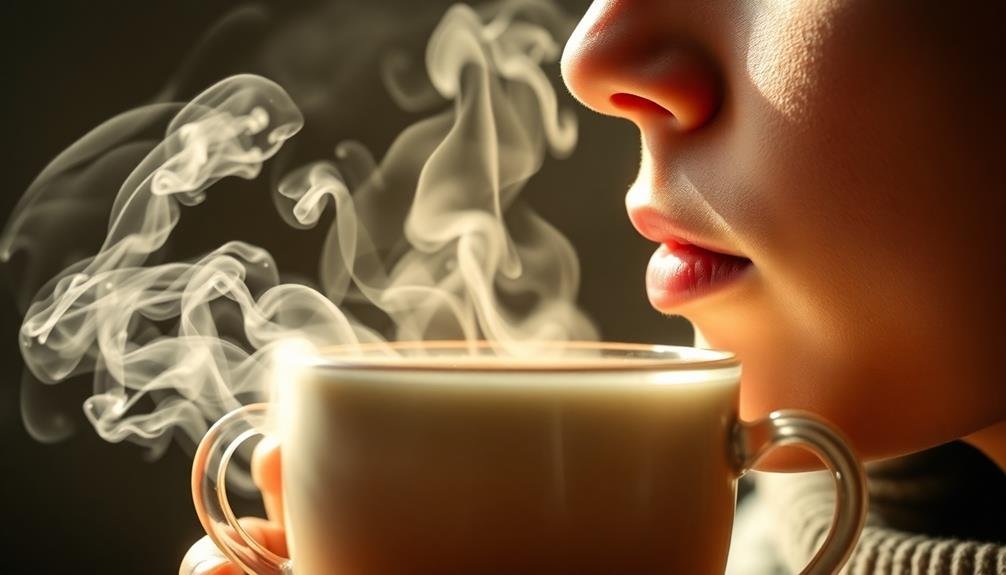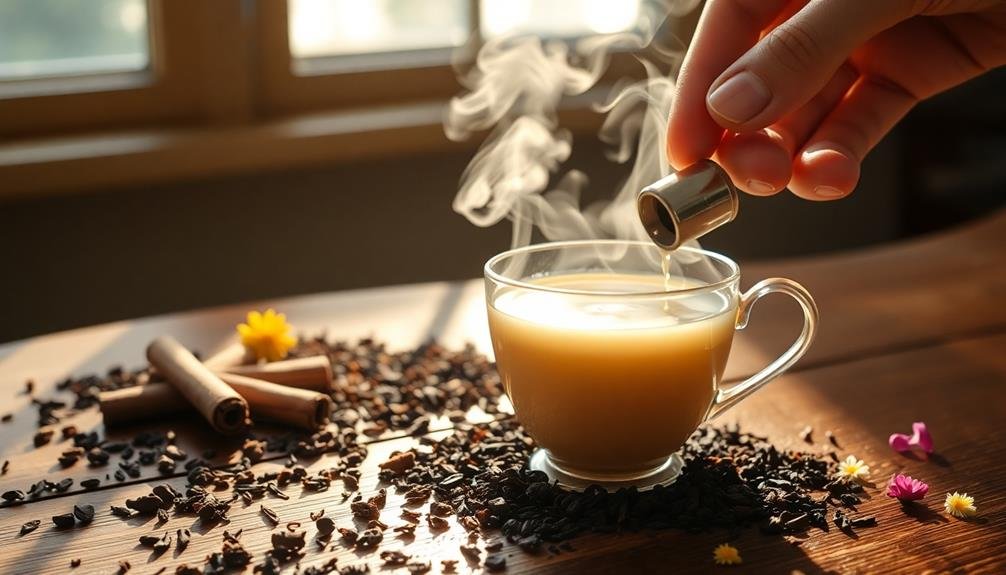To evaluate herbal tea aromas like a pro, start with the Dry Leaf Sniff to observe and inhale the tea's initial scent. Next, try the Hot Water Bloom Method to experience how heat changes the aroma profile. Use Retronasal Olfaction to detect subtle notes through your mouth and throat. Practice Cupping and Slurping to aerate the tea and spread flavors across your palate. Finally, employ an Aroma Wheel Analysis to identify and describe complex scents accurately. These five techniques will sharpen your senses and help you appreciate the nuanced world of herbal teas. Dive deeper to reveal the full potential of your tea-tasting journey.
The Dry Leaf Sniff

Anticipation builds as you prepare to evaluate your herbal tea. The first step in your aromatic journey is the dry leaf sniff, an essential technique that sets the stage for your entire tasting experience.
Begin by gently opening the container or packet holding your herbal tea. Take a moment to observe the leaves' appearance, noting their color, shape, and texture.
Now, bring the container close to your nose and take a deep, slow inhale. Close your eyes to focus solely on the scent. What do you detect? Identify the primary aromas, which might include floral, fruity, earthy, or spicy notes.
Don't rush this process; take several sniffs if needed. As you breathe in, consider the intensity of the aroma. Is it bold and pronounced, or subtle and delicate?
Pay attention to any changes in the scent as you continue sniffing. Some aromas may become more apparent over time, while others might fade.
This dry leaf evaluation provides valuable insights into the tea's character and helps you anticipate the flavors you'll experience once brewed. Remember, the dry leaf aroma is just the beginning of your herbal tea adventure.
Hot Water Bloom Method
With the dry leaf evaluation complete, it's time to reveal the next layer of your herbal tea's aromatic profile. The Hot Water Bloom Method allows you to experience the tea's scent as it unfolds with heat.
Begin by placing a small amount of your herbal tea in a warm, dry vessel. Slowly pour hot water over the leaves, filling the vessel about halfway. Immediately cover it with a lid to trap the rising steam and aroma compounds.
After 30 seconds, remove the lid and inhale deeply. You'll notice a significant difference from the dry leaf scent. The heat releases volatile compounds, creating a more complex and nuanced aroma profile.
Pay attention to new scents that emerge, as well as how the existing notes may have intensified or changed.
This method often evokes strong emotions, as it:
- Awakens your senses with a burst of fragrant steam
- Builds anticipation for the flavors to come
- Connects you more intimately with the tea's character
As you practice the Hot Water Bloom Method, you'll develop a keener sense for distinguishing subtle aromatic notes and predicting how the brewed tea will taste.
This technique is an essential step in fully appreciating the complexity of your herbal tea.
Retronasal Olfaction Technique

The Retronasal Olfaction Technique takes your herbal tea evaluation to the next level. This method focuses on the aromas you perceive through your mouth and throat, rather than just your nose. To practice this technique, you'll need to sip the tea and hold it in your mouth for a few seconds before swallowing.
As you swallow, breathe out slowly through your nose. This action forces the aromatic compounds in the tea to travel up your nasal passages from the back of your throat. You'll notice different scents and flavors than you did when simply smelling the tea from the cup. The retronasal technique allows you to detect more subtle notes and complexities in the herbal blend.
To enhance your experience, try cupping your hand over your nose and mouth as you exhale. This traps the aromas and intensifies them, making it easier to identify individual components.
With practice, you'll be able to distinguish between different herbs, spices, and floral notes in your tea. The Retronasal Olfaction Technique is particularly useful for evaluating complex herbal blends and identifying any off-flavors or imbalances in the tea's aroma profile.
Cupping and Slurping
Cupping-and-slurping experts know that this technique is essential for a thorough herbal tea evaluation.
You'll want to start by pouring the brewed tea into a wide-mouthed cup, allowing it to cool slightly. As you prepare to taste, hold the cup close to your nose and inhale deeply, taking in the initial aroma.
Now comes the fun part: slurping. Take a small amount of tea into your mouth and quickly draw in air, creating a slurping sound. This action aerates the tea, spreading it across your palate and allowing you to detect subtle flavor notes.
As you practice this technique, you'll develop a keen sense for identifying various herbal components.
The cupping-and-slurping method offers several benefits:
- It intensifies the tea's flavors, making them more pronounced
- It helps you distinguish between different herbal notes
- It allows you to experience the tea's mouthfeel and texture
Aroma Wheel Analysis

After mastering cupping and slurping, you'll want to explore aroma wheel analysis. This technique uses a visual tool called an aroma wheel to help you identify and describe the complex scents in herbal teas. The wheel is divided into categories and subcategories, radiating from the center outward, with more specific descriptors on the outer rings.
To use the aroma wheel, start by smelling your brewed tea and identifying the broad category of aroma, such as floral, fruity, or earthy. Then, work your way outward on the wheel to pinpoint more precise descriptors. For example, if you detect a floral scent, you might narrow it down to jasmine or lavender.
As you practice, you'll develop a more refined palate and expand your aroma vocabulary. This skill will help you articulate the nuances of different herbal teas more accurately.
You can even create your own customized aroma wheel for specific types of herbal teas you frequently evaluate. Remember, aroma wheel analysis is a valuable complement to cupping and slurping, enhancing your overall tea evaluation skills.
Frequently Asked Questions
How Do Storage Conditions Affect the Aroma of Herbal Teas?
You'll notice storage conditions greatly impact herbal tea aromas. Heat, light, and moisture can degrade essential oils and volatile compounds. Keep your teas in airtight containers in a cool, dark place to preserve their fragrant qualities.
Can Certain Medications Influence One's Perception of Tea Aromas?
Yes, certain medications can affect your sense of smell and taste, altering how you perceive tea aromas. Some drugs may dull your senses, while others can enhance them or cause unpleasant taste distortions. It's important to consult your doctor.
What Role Does Water Quality Play in Herbal Tea Aroma Evaluation?
You'll find that water quality greatly impacts herbal tea aroma. It's essential to use pure, filtered water as impurities can alter the tea's scent. Hard water or chlorinated water can mask or distort the delicate aromas you're trying to evaluate.
Are There Specific Tea Accessories That Enhance Aroma Appreciation?
You'll find several accessories that enhance aroma appreciation. Try using a porcelain gaiwan, which concentrates scents. Invest in a tea tray to catch spills. Don't forget aroma cups, which are specifically designed to amplify fragrances.
How Does Altitude Impact the Aromatic Compounds in Herbal Teas?
You'll find that higher altitudes can intensify aromatic compounds in herbal teas. The cooler temperatures and increased UV exposure affect plant growth, often resulting in stronger, more complex aromas in the leaves you'll brew.
In Summary
You've now learned five expert techniques for evaluating herbal tea aromas. By practicing these methods, you'll develop a more refined palate and deepen your appreciation for the complex scents in your favorite brews. Remember, there's no right or wrong way to experience tea aromas – it's a personal journey. Trust your senses, experiment with different approaches, and most importantly, enjoy the process of discovering new dimensions in your daily cup of herbal tea.





Leave a Reply